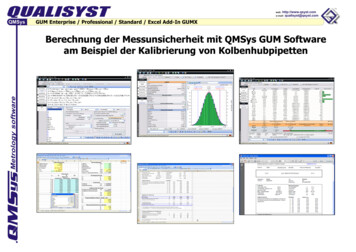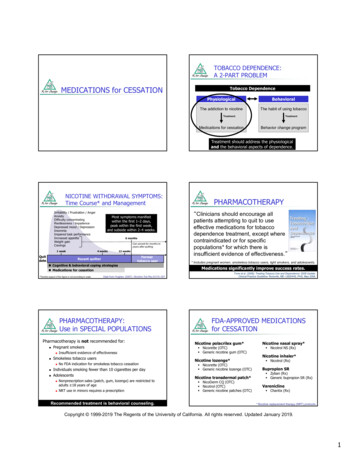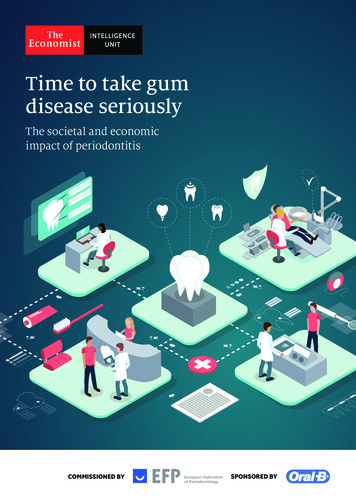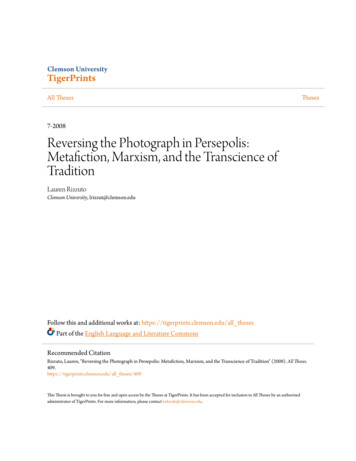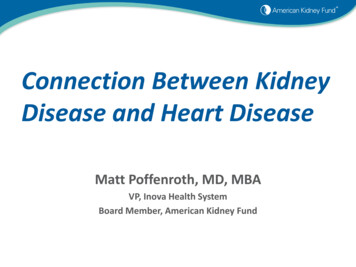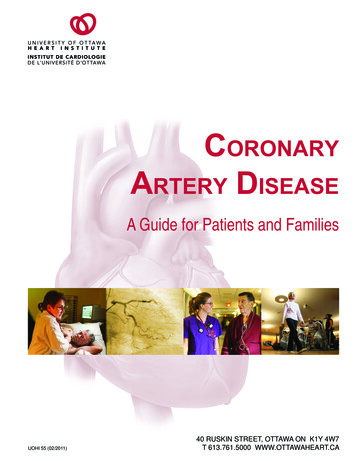
Transcription
REVERSINGGUM DISEASENATURALLYA Holistic Home Care ProgramSandra Senzon, R.D.H.John Wiley & Sons, Inc.
Praise forReversing Gum Disease Naturally“Reversing Gum Disease Naturally emphasizes theblending of the classical and holistic approaches to oralhygienic health care. Sandra Senzon, R.D.H., emphasizesthe gentle, natural nurturing of the gingival tissues in orderto resist bacterial invasion, and thus maintain your propergingival health. She also stresses the concept of teethlasting for a lifetime through enlightened prevention,including proper home care and oral hygiene. This bookallows the patient to be an active participant along withhealthcare professionals.”—Jay P. Goldsmith, D.M.D.“Reversing Gum Disease Naturally presents techniques andinformation so that you can reverse already unhealthy statesin your mouth or prevent the onset of gum disease. SandraSenzon enhances patients’ oral health through traditional aswell as holistic methods.”—Barry Musikant, D.M.D.“After reading Sandra Senzon’s book, there is a ray of hopeat the end of the tunnel for all those who suffer from gumdisease. We ultimately don’t have to lose our natural teeth.Sandra Senzon shows us the many ways in which the mouthis connected to the body, and how, with the use of naturalherbal products and proper mechanic techniques, you canreverse gum disease naturally.”—Joseph P. Greer, D.O.S.
REVERSINGGUM DISEASENATURALLY
REVERSINGGUM DISEASENATURALLYA Holistic Home Care ProgramSandra Senzon, R.D.H.John Wiley & Sons, Inc.
Copyright 2003 by Sandra Senzon. All rights reservedIllustrations copyright 2003 by Aaron Campbell. All rights reserved.Published by John Wiley & Sons, Inc., Hoboken, New JerseyPublished simultaneously in CanadaNo part of this publication may be reproduced, stored in a retrieval system, ortransmitted in any form or by any means, electronic, mechanical, photocopying,recording, scanning, or otherwise, except as permitted under Section 107 or 108of the 1976 United States Copyright Act, without either the prior writtenpermission of the Publisher, or authorization through payment of the appropriateper-copy fee to the Copyright Clearance Center, 222 Rosewood Drive, Danvers,MA 01923, (978) 750-8400, fax (978) 750-4470, or on the web atwww.copyright.com. Requests to the Publisher for permission should beaddressed to the Permissions Department, John Wiley & Sons, Inc., 111 RiverStreet, Hoboken, NJ 07030, (201) 748-6011, fax (201) 748-6008, email:permcoordinator@wiley.com.The information contained in this book is not intended to serve as a replacementfor professional medical advice. Any use of the information in this book is at thereader’s discretion. The author and the publishser specifically disclaim any and allliability arising directly or indirectly from the use or application of anyinformation contained in this book. A health care professional should beconsulted regarding your specific situation.For general information about our other products and services, please contact ourCustomer Care Department within the United States at (800) 762-2974, outsidethe United States at (317) 572-3993 or fax (317) 572-4002.Wiley also publishes its books in a variety of electronic formats. Some contentthat appears in print may not be available in electronic books. For moreinformation about Wiley products, visit our web site at www.wiley.com.Library of Congress Cataloging-in-Publication Data:Senzon, Sandra.Reversing gum disease naturally : a holistic home care program. / SandraSenzon.p. ; cm.Includes bibliographical references and index.ISBN 0-471-22230-5 (paper)1. Gums—Diseases—Alternative treatment. 2. Periodontaldisease—Alternative treatment. 3. Naturopathy.[DNLM: 1. Gingival Diseases—therapy—Popular Works. 2. HolisticHealth—Popular Works. 3. Nautropathy—Popular Works. 4. PreventiveDentistry—methods—Popular Works. WU 240 S478r 2003] I. Title.RK401 .S46 2003617.6′32—dc212002153471Printed in the United States of America10987654321
To my patients, who have kept me going intrying times, and to the dentists, who havegrown to love my style.
ContentsForeword by Mitchell Charnas, D.M.D.AcknowledgmentsIntroductionxixiii1PART I. ABOUT GUM DISEASE1. Gum Disease: Its Signs, and the First StepsToward Healing57Understanding Gum DiseaseSigns of DiseaseThe History of Gum DiseaseThe Natural Process of Healing: How It BeginsHow to Start Caring for Your Gums at Home791317202. The Mouth Is a Mirror of the Body: Diseasesof the Body and Medications That CanAffect Your Gums25Conditions of the Body That Cause Gum Disease 25Medications and Their Effects on Gum Disease36The Role Tobacco Plays39vii
Contents3. Stress and Its Effect on Gum DiseaseWhy Stress Is the CulpritUsing the Mind-Body-Spirit Connection toEliminate the Effects of StressStress-Related Habits That Worsen Gum DiseasePART II. HEALING MODALITIES AND TOTALBODY CARE4. Handling Pain and FearMouth Conditions That Can Cause PainChildren and Pain in DentistryEliminating FearReducing Our Stress Level5. Working with Holistic Products for theNatural Reversal of Gum DiseaseWhy Is It Better to Use Natural Products?Natural Products for Reversing Gum DiseaseAromatherapy and Its Use in Gum Therapy6. Therapeutic HealingTherapeutic Healing Used for the NaturalReversal of Gum DiseaseEnergetic Relations of Teeth with Organsof the BodyUsing Therapeutic Healing with Oral CareProductsWhat about Electric Toothbrushes?7. Diet and SupplementsWhy Diet Plays an Important 102109116119119121
ContentsMineralsEssential Gum NutrientsGetting Motivated to Eat HealthyMacrobiotics127132135137PART III. PROFESSIONAL DENTAL HINTS1418. Charting Success for the Reversal ofGum Disease143Charting and Drawing an Outline ofYour MouthOnce You’ve Made Your First ChartA Healthy Mouth1431491509. Setting Up an At-Home Hygiene Center:The Tooth Spa ProgramAn At-Home Spa Approach to DentalHygieneThe Tooth Spa Hygiene StationCreating Good Habits and Finding theMotivation15115115215910. Finding the Right Professional to Guide Youin the Natural Reversal of Gum Disease161How to Find the Right Professional for theCare of Your Gums and TeethFinding the Right Dental HygienistHow to Work with a Conventional DentalPractitioner in Natural Healing16116617011. For Parents: Your Role in Preventing GumDisease in Children171All about GermsTeaching Your Child about Gum Massage171172ix
ContentsMotivating Your ChildPutting Together a Child’s At-Home HygieneStationHelpful HintsTips on Finding a Good Dental Professionalfor Your ChildSystemic Diseases Affecting Early Onset ofPeriodontal DiseaseThe Teen Years12. Now You Can Reverse Gum DiseaseNaturallySummarizing the Contributors That CanLead to Gum DiseaseChildren and Gum DiseaseAppendix: Resources for Natural 190193197199
ForewordIf you feel that you lack control in the dental office, theproblem might be a lack of information. Reversing GumDisease Naturally is an in-depth discussion of the oral cavity and its relationship to the rest of the body, and it is written on a level that both the dental professional and thelayperson can understand. In simple terms, Sandra Senzon,R.D.H., increases your dental IQ, which can give you greatercontrol when you work with dental professionals.I first became acquainted with Sandra, a registered dental hygienist, when she began treating patients in my officeon Madison Avenue in New York City. Sandra has beenactive in clinical treatment since 1977. She has an extensivefollowing of loyal patients who have continued to improveperiodontally as a result of her techniques, which are welldescribed in this book. They include natural, nonsurgicalperiodontal treatments and state-of-the-art cleaning withherbs, coupled with education about hygiene at home andquality dentistry.The material in this book is up-to-date, practical, andwell presented. It encompasses the full scope of conditionsxi
Forewordof the body and their relationship to the oral cavity. AsSandra puts it, “The mouth is a mirror of the body’s health.”Sandra has worked tirelessly to put the mouth and body intoa natural balance, and she draws on over twenty-five years ofexperience in treating patients’ gums and in presenting apractical and natural approach to her work. This informativebook is for all those who are concerned about the health oftheir mouth.— Mitchell Charnas, D.M.D.xii
AcknowledgmentsI give special thanks to my publisher, who saw merit in thisbook, and to my agent, Jeff Herman, who believed in me.My children, Eric and Bari, have always been there with aspecial kind of support. Thanks also to the artist, Aaron. Allof you are wonderful.I also thank myself for having the courage to write aboutthis topic in a humanistic manner!xiii
IntroductionHave you been told that you have periodontal disease? Doyou dread losing your teeth? My book will guide you to thetruth about gum disease. Reversing Gum Disease Naturallyis packed with information you need to help you keep yournatural teeth. Treatment of gum disease does not have to bethe painful experience that unfortunately has been for someof my patients who have been treated by hygienists practicing other techniques. Reading this book will acquaint youwith oral hygiene and help you learn what you can do tokeep healthy gums and teeth.Gum tissue is a covering around the roots of our teeththat is in great need of massage and cleansing. We abuse ourmouths regularly by grinding and clenching our teeth, andby eating foods with sugar and spices. Many of us also eatsticky, adhesive-type foods. At my hygiene center, I work1
Reversing Gum Disease Naturallywith natural herbs that feed the gum tissue in healthy ways.Ninety percent of the cure for gum disease entails not onlypatient education but motivation in terms of dental hygienehome care. Proper instruction will allow and foster corrective home care maintenance.Articles and advertisements on plaque and tartar talkabout bacteria invading the structures of the mouth. Butwhat about the fragile tissue that holds these bacteria? If wecondition gum tissue on a regular basis, we would not havea holding pocket for food and bacteria to sit next to the toothand bone! Bacteria will always be present in the body andmouth, but we can learn to nurture our mouth and gentlybring it to a healthy state.When I began my career twenty-six years ago, I saw thatpeople had tremendous problems with the loss of adult teeth.Even though I was instructed to teach patients to brush andfloss, I saw that brushing and flossing were not enough. Inoticed that the patients’ gum tissue seemed stretched andloose around crowns and bridges, areas where there is muchirritation to the surrounding tissue due to crown margins andmaterials used for crowns and bridges. As I continued toevaluate the condition of these patients, I saw the need forgreater tissue-hygiene control.As a dedicated practitioner, I researched and evaluatedproducts from all over the world that can help heal theseconditions, and I brought them back home to offer to myown patients. I developed and marketed a “home care kit”containing a toothbrush, baking soda toothpaste, rubber tip,mirror, and instructional brochure. This kit has been promoted at the International Gift Show and at dental tradeshows. As a result of this, I have been interviewed by many2
Introductiontrade magazines. I continue to get a great deal of publicityfor my efforts, and this has led me to travel all over the worldseeking the best products that are available.I now have a Tooth Spa on Madison Avenue in New YorkCity, where my colleagues and I work on gums as well asclean and whiten teeth. I had a book published, The HygieneProfessional: A Partner in Dentistry, to help train other dental hygienists to work in the same fashion. After the evolution of the Tooth Spa came the creation of a character aptlynamed the Tooth Fairy. Using this character, I initiated thefirst dental hygiene educational show on cable television,called The Tooth Fairy Show. I have written a series of fivechildren’s books, Tooth Fairy City, to help motivate and educate children, and have even lectured in hospitals andschools dressed as the Tooth Fairy!After reading my book, you will have an excellentchance of keeping your teeth and gums healthy, and you willnot be misled by the “business” of dentistry. The information contained in this book will help you work better withyour dental professional, and also to control the maintenance of your mouth by yourself. Your teeth and gums willlet you know how they are feeling, and as you becomeacquainted with various problems, you will be able to workon them as they arise. Whatever you do, do not wait until theproblems become so severe that they are more difficult toreverse.3
PART IABOUT GUM DISEASEPart I will describe gum disease and its onset. In these chapters, you will get a new and broader understanding of yourmouth and how it is a mirror of your body. Stress, fear, andpain are major causes of gum disease, and in Part I, healingmodalities will be discussed on how to reduce stress, pain,and fear.Read on, and you will be delighted to see that the mouthis connected to the total body. You will begin to reverse gumdisease naturally!
1Gum DiseaseIts Signs, and the First StepsToward HealingUnderstanding Gum DiseaseWith increased awareness of periodontal disease and agreater selection of dental hygiene products available, whyis gum disease the most commonly diagnosed health problem among today’s American adult population, affectingapproximately 40 million people? Since this disease of themouth has a destructive nature, it is important that you follow the guidelines described in this book to help begin thehealing process. People have been losing their teeth as partof the aging process; however, with routine cleanings andgood home care, we can all keep our natural teeth. If youexercise preventive care, it is not unreasonable to expectyour teeth and gums to last a lifetime.To understand gum disease in simple terms, think of yourteeth rooted in bone the way a plant is rooted in soil. If thesoil supporting the plant begins to erode, the plant will7
Tooth rooted in bone.Plant rooted in soil.8
Gum Diseaseloosen and bend. The same thing can happen with yourteeth. If the bone that supports the teeth in their socketsbegins to erode, the teeth will loosen and fall out.The first stage of periodontal disease is called gingivitis:gingiv (gum tissue) and itis (inflammation). This initial stageis characterized by loose, swollen, tender, and/or bleedinggums. The loose, flabby gum tissue allows pockets to formbetween the teeth and the gum tissue—pockets in whichfood debris can collect and harmful bacteria can multiply.The bacteria may then attack the neighboring jawbone, causing it to erode. When bone loss has occurred, the disease hasprogressed to the second stage. This is known as periodontitis, and is classified as early, moderate, or advanced,depending on the degree of bone destruction.What causes gingivitis? Gingivitis is a bacterial infectionof the gum tissue. Bacteria live in plaque, a sticky film thataccumulates on your teeth every day. Plaque needs to beremoved by proper oral home care. If it is not removed properly, the toxins in the plaque will cause the gums to get irritated and infected. Plaque left on the teeth and not disruptedby brushing and flossing will calcify and turn into calculus(commonly called “tartar”). Brushing and flossing cannotremove calculus; it must be removed by a professional.Calculus found caked on the roots of diseased teeth, in addition to containing bacterial toxins, is a mechanical irritant tothe soft tissue.Signs of DiseaseThere are many signs that indicate the presence of gum disease. They can include:9
Reversing Gum Disease Naturally Halitosis, or bad breath. An end product of this disease process and tissue breakdown is very often mouthmalodor, or halitosis, commonly called “bad breath.”Although halitosis is a common symptom of periodontal disease, it may be caused by other health problemsor conditions as well, such as gastritis (acid stomach).If your breath is sour in the morning, it might be dueto dehydration or loss of saliva during sleep. And certain allergies can leave a bacterial mucous that mixeswith your saliva and causes bad breath. Many medications also have side effects that can leave you with badbreath. Therefore, you should seek out a professionalfor a diagnosis of what is causing the halitosis.However, to determine if you have halitosis, cupyour hands over your mouth and breathe out. Thensmell. If you detect an odor, then you probably havebad breath. Or ask your spouse or a close friend toinform you if you have this problem. To determine ifthe halitosis is originating from your mouth, trysmelling your dental floss after you have used it. If thefloss has a foul odor, the halitosis is probably emanating from your teeth and gums. Malpositioned teeth. Another warning sign of periodontal disease is loose and malpositioned teeth. Teethwill move out of place due to bone loss. If your teethare moving out of position and seem to overlap, or ifgaps are forming between your teeth, this may be awarning sign that you have gum disease. There areother reasons for loose teeth, such as a fractured root,so do seek a professional to obtain a proper diagnosis.Do not try to diagnose the condition yourself!10
Gum DiseaseReceding gums. Receding gums. Have you ever heard the expression,“long in the tooth”? This is used to describe recedinggums, or gums that are “backing away” from the teeth.The condition is the result of gum and bone loss andsubsequent root exposure, thus giving the tooth alonger appearance. Sensitivity can occur as well,because the root does not have an enamel covering.Enamel covers the crowns of your teeth and acts as aprotective covering. Bleeding gums. Do your gums bleed when you brushyour teeth? Bleeding around your gums is an importantindication of periodontal disease and is often the firstsign you may notice. Bleeding, as well as inflammationand irritation of the gums, may also signal other medical problems, so do not ignore these signs. Seek a professional opinion. Such bleeding also can be a result of11
Reversing Gum Disease Naturallythe gum tissue drying out. This can occur if you wearbraces or have other problems that keep your lips fromclosing over your teeth. Allergies may block the nasalpassages, leaving you no choice but to breathe throughyour mouth. The result of mouth breathing, rather thanbreathing through your nose with your mouth closed,may be gingivitis. An open mouth can cause the tissueto dry out and become loose and irritated. Or, if youhave allergies and your saliva has a lot of excess bacteria and mucous, the fragile gum tissue can becomeinfected. People who suffer from postnasal drip have agreat deal of mucus in the saliva, and this causes irritated gums. Gum abscesses. A gum abscess can be another sign ofgum disease. If an area of your mouth appears to havea swelling or a lump above the tooth, then you mayAbscessed tooth.12
Gum Diseasewell have a gum abscess. The invasive bacteria withinthe abscess will eat away at the supportive bone. Theonset of gum disease can begin with just one abscesson one tooth. Bacteria will eat away at the bone surrounding the tooth, resulting in less support to thetooth and ultimately in tooth loss if not properly caredfor. An abscess does not necessarily have pain associated with it, but you may have an additional problemoriginating in the nerve, which will cause pain.Gum disease is insidious and can progress without yourknowledge. Any early signs of this disease, as describedabove, need your immediate attention. If you lose bone,which roots your teeth into their sockets, your teeth will lacksupport and will loosen or fall out. Bone, ligaments, andgum tissue all support the positioning of the teeth. But diseased conditions of our body can be reversed as long as wedo not deny that they exist.The History of Gum DiseaseLuckily, many dentists have been true pioneers in the prevention of tooth loss and have helped create the techniquesand instruments for scaling teeth that are used today.Knowledge of gum disease dates back as far as 1746,when Dr. Pierre Fauchard, a surgeon-dentist who is knownas the father of modern dentistry, wrote a paper titled LeChirurgien Dentiste that described gum disease. Dr.Fauchard advised patients to wash out their mouths withtepid water after having cleaned their teeth. After theyrinsed, he advised patients to rub the teeth from below13
Reversing Gum Disease Naturallyupward, and from above downward—outside and inside—with a little sponge dipped in water. He also claimed it wasgood to use a half-round toothpick to remove what he calledthe “fur” that collects on or between the teeth and gums during the night. His advice to remove this sticky film with atoothpick was very advanced for his time, and his ideas presaged today’s use of picks to scale teeth.In 1845 Dr. John Hankey Riggs was the first to call attention to gum disease in America. Periodontal disease thusbecame known as “Riggs disease.” Few professionals currently refer to gum disease as Riggs disease, however.Today’s terms are: gum disease, periodontal disease, or gingivitis. My own approach is much the same as his: to treatthe condition as a curable disease by cleaning the pocketssurrounding the teeth. With a thorough cleaning, the bacteria and toxins are removed from between the teeth and surrounding bone, thus reversing gum disease.Dr. Riggs is given credit for designing scalers andcurettes—instruments that we still use today to remove thehardened stone (tartar) from the roots of our teeth and thediseased layer of granular (thickened diseased tissue) thatsits next to the tartar. The roots of our teeth are not straightup and down, but curve at angles under the gum tissue.Thus the scalers and curettes were designed with contraangles (curved angles) to conform to the roots and removeany material in the pockets. A dental cleaning using theseinstruments is the most important preventive treatment forperiodontal disease.One of the first dentists in America to establish a preventive dental practice was Dr. David Smith of Philadelphia in1894. Prophylactic services (cleaning of teeth), although14
Gum DiseaseClinical instrument with curved angles.beneficial to patients, were time-consuming, and so reducedthe amount of time dentists were able to allocate to restorative treatment. Thus there were fewer dentists back then whoperformed preventive care. Most were restorative dentists,who focused on fixing the nonregenerative enamel anddentin, the hardened materials of our teeth. Dr. Alfred C.Fones, another pioneer, believed that training auxiliary personnel to provide prophylactic care was an efficient solutionto this problem. Dental hygiene thus can be traced back toDr. Fones, as he felt there should be a separation betweenrestorative care and gum disease, and he was the first to initiate a program for dental hygiene. A dental hygienist is alicensed professional who cleans away the tartar (hardenedplaque) from the teeth and roots under the gums. Dr. Fonescreated a school for dental hygiene in Bridgeport,Connecticut, in 1898.15
Reversing Gum Disease NaturallyIt was understood even then that not enough emphasiswas put on educating children and teaching them the importance of proper oral hygiene. It was known as far back as1898 that a clean tooth would not decay. So dental hygienebecame an important profession in helping adults and children prevent adult tooth decay and tooth loss. The dentalhygienist would clean teeth, educate and motivate thepatients in home care, and then recommend treatment forrestorative care by the dentist. The dental hygienist’s rolewas an important one—even more than it is today—for therewere fewer dentists at that time.In 1939 Dr. A. W. Byran tried to make the dental profession aware of causative factors in gum disease andattempted to have the profession focus on prevention anddiagnosis, rather than only on the symptoms of the disease. He argued against drug treatment, maintaining thatunless the drugs were directed at a specific site of infection, they were not treating the condition scientifically. Hewas also against the surgical removal of unattached tissuebecause it did not address the cause and only dealt withsymptoms.Dr. Byran and Dr. Riggs had more insight into the subject of the reversal of gum disease naturally than many gumspecialists (periodontists) do today, as cutting away at diseased and unattached tissue is still widely practiced. Whilesurgical removal of gum tissue instantly shrinks the pocketcollecting bacteria, the tissue remains thinner at a higherpoint on the tooth. And if the periodontist does not addressthe cause and motivate the person to practice proper homecare and oral hygiene, the condition can appear again andcause breakdown in a more vulnerable area.16
Gum DiseaseSurgical removal of a pocket.The Natural Process of Healing:How It BeginsThe natural reversal process of gum disease starts withproper instrumentation in the dental office. If you havegum disease, the first step is to go to a dentist’s office fora cleaning. Dental hygienists and dentists are trainedspecifically to treat the gums and provide proper cleaningsto help eliminate the hardened material or tartar thatattaches to the tooth and root structure. It is important forthe hygienist or the dentist to do a thorough cleaning andto work with hand instruments (see chapter 6) for these17
Reversing Gum Disease Naturallyprocedures. Many offices today rely on high-tech equipment such as the ultrasonic scaler and the Prophy Jet. Butfocused therapeutic healing can also come from the practitioner, traveling through the hands, through the instruments, and into the patient’s mouth. High-tech instruments,such as the sonic scaler (high-speed ultrasonic tartarremover), can be an obstacle to this kind of healing.(Therapeutic healing will be discussed in chapter 6.)Your mouth may require more than one cleaning; it alldepends on the severity of your condition. If your mouth isin the second or third stage of periodontal disease, then youmight have to return for three or four treatments. A returnfor maintenance can be as frequent as four or five times ayear. After a root planing treatment (a cleaning of the rootsso that healing can take place), the tissue will begin to reattach to the root and return to a healthy state. After theremoval of tartar, you can use a natural process at home toheal the tissue (this will be discussed in chapter 9). This isequally as important as getting a thorough professionalcleaning. Proper home care can help speed up the results ofthe gum treatments that are done in the dental office.After you have root planing and scaling in the dentist’soffice, you will discover that your gum tissue will be soreand fragile. So go home and use distilled warm water withsea salt or an herbal rinse, preferably Dr. Vogel’s Bioforce(Dentaforce), to enable the tissue to heal. Rinse your mouthfrequently and also massage the tissue with a soft brush.Such soreness tells us it is important to work in a slow andcareful fashion. You would not beat up on a wound that wasraw and new. So keep in mind that all healing is a gentleprocess and takes time.18
Gum DiseaseThese are the six steps that will happen when you go infor a holistic cleaning or gum treatment.1. The dentist or periodontist reviews the patient’s condition and charts the pockets with a periodontal probe(Pockets over 4 mm are considered a prerequisite forgum disease.) Charting of the teeth allows professionals to make note of their evaluation of yourmouth. They will also document crowns and bridges,missing teeth, teeth that show broken fillings, andteeth that have decay and need fillings or root canals.2. The dentist suggests a treatment plan. Since everyoneheals differently, it may take longer for some people,and they may need several appointments.3. The professional provides cleanings, preferably withhand instrumentation. Ideally, an instrument is dippedin oreganol (oil of oregano), olive oil, or clove oil, andthen in echinacea toothpaste or another natural toothpaste. The oreganol or clove oil acts as a lubricant andnatural numbing agent. The echinacea or naturaltoothpaste feeds the new cells of the gum.4. The patient uses a rinse, preferably herbal, to rid themouth of disease.5. The professional conducts a brush massage of thegums to soothe the irritated tissue and teach the patientthe therapeutic methods of massaging the gums. Atthis point, the patient rinses again.6. The professional provides a review of home careinstruction. The patient is often given a package thatusually contains toothpaste (herbal or baking soda ispreferred) for cleansing and healing of the tissue,19
Reversing Gum Disease Naturallymouth rinse, toothbrush, and perhaps selected herbalproducts. The professional then advises the patient onhow to start caring for the gums at home.How to Start Caring for Your Gumsat HomeGum tissue is connected to the bone by fibers. You canachieve reattachment of these gum fibers by using a gentlemassaging stroke with a soft brush. So, using the side of asmall-headed, soft toothbrush that has a dab of herbal toothpaste on it, gently massage the tissue with a shimmying sideto-side stroke.Such massage stimulates circulation, which aids healingin the gum tissue. Using a massage stroke with a soft brushwill help you bring the healing blood cells of the gums to thesurface. It is the healing cells of the gums that will help toreattach gum tissue to the tooth. Think of the skin on yourBrush massage.20
Gum Diseaseface. If you massage the skin on your face and create morecirculation, then you are more likely to get a healthier andtigh
Reversing Gum Disease Naturally "Reversing Gum Disease Naturallyemphasizes the blending of the classical and holistic approaches to oral hygienic health care. Sandra Senzon, R.D.H., emphasizes the gentle, natural nurturing of the gingival tissues in order to resist bacterial invasion, and thus maintain your proper gingival health.



